How much information is lost when music files are being compressed?
Here are (3) short 10sec samples - in WAV (1411kbps, CD quality), in 320kbps and in 185kbps.
I converted all samples to mp4 files (320kbps) so I could directly attached them for quick listening.
I did attached the master files as zip for more detailed comparison.
You can take a listen and judge for yourself...
-
Here are (3) short 10sec samples - in WAV (1411kbps, CD quality), in 320kbps and in 185kbps.
I converted all samples to mp4 files (320kbps) so I could directly attached them for quick listening.
I did attached the master files as zip for more detailed comparison.
You can take a listen and judge for yourself...
-
Attachments
-
01 Bad Michael Jackson Bad - WAV - 10sec.mp4393 KB
-
320kbps_10sec_01 Bad Michael Jackson Bad.mp4396.9 KB
-
185kbps_10sec_01 Bad Michael Jackson Bad.mp4377.1 KB
-
01 Bad Michael Jackson Bad - WAV - 10sec.zip1.6 MB · Views: 58
-
320kbps_10sec_01 Bad Michael Jackson Bad.zip1.6 MB · Views: 58
-
185kbps_10sec_01 Bad Michael Jackson Bad.zip1.6 MB · Views: 42
Now, here is the interesting part - those samples below play the difference between the original WAV file (1411kbps) and the compressed files (320kbps and 185kbps).
That is the amount of audio which is lost..
-
That is the amount of audio which is lost..
-
Attachments
And at the end - some audio spectral comparison..
-
-
Attachments
-
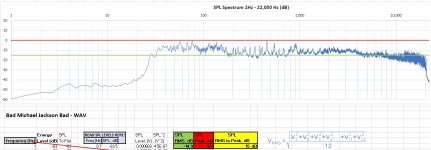 Bad Michael Jackson Bad - WAV.jpg138.3 KB · Views: 191
Bad Michael Jackson Bad - WAV.jpg138.3 KB · Views: 191 -
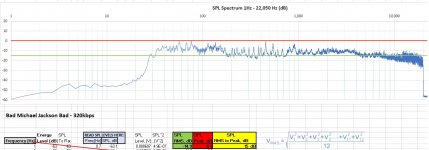 Bad Michael Jackson Bad - 320kbps.jpg143.2 KB · Views: 196
Bad Michael Jackson Bad - 320kbps.jpg143.2 KB · Views: 196 -
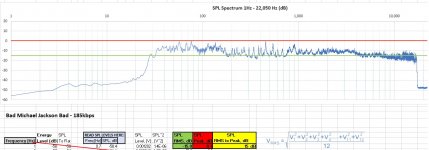 Bad Michael Jackson Bad - 185kbps.jpg142.7 KB · Views: 191
Bad Michael Jackson Bad - 185kbps.jpg142.7 KB · Views: 191 -
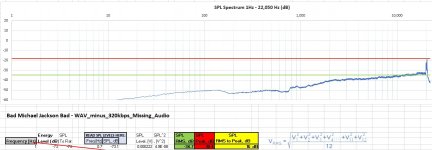 Bad Michael Jackson Bad - WAV_minus_320kbps_Missing_Audio.jpg135.3 KB · Views: 191
Bad Michael Jackson Bad - WAV_minus_320kbps_Missing_Audio.jpg135.3 KB · Views: 191 -
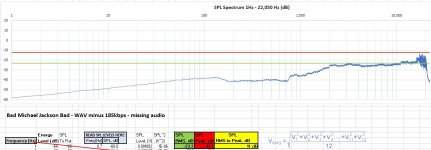 Bad Michael Jackson Bad - WAV_minus_185kbps_Missing_Audio.jpg134.3 KB · Views: 196
Bad Michael Jackson Bad - WAV_minus_185kbps_Missing_Audio.jpg134.3 KB · Views: 196
16 bit CD is already a very lossy way of storing musical files. It was always considered that when it was designed. Sony and Philips never argues at its inception and promised a superior format later.
The SACD format that followed using DSD to circumvent copying cheaply also suffered a slight loss but nowhere neat the 10 to 15 percent of CD. Whilst improvements have been made to the original CD design it is and always will be a compromise.
Cutting it down further and using other lossy formats will never improve the sound viz its original. Try listening to a half decent HiRez set of files played with non CD designed speakers (Less that 22.1k hz )and then compare both the pure original sounds and you will then be on the starting path of proper high resolution.
Obviously this will cost.
Measuring an already lost set of sonics is pointless?
The SACD format that followed using DSD to circumvent copying cheaply also suffered a slight loss but nowhere neat the 10 to 15 percent of CD. Whilst improvements have been made to the original CD design it is and always will be a compromise.
Cutting it down further and using other lossy formats will never improve the sound viz its original. Try listening to a half decent HiRez set of files played with non CD designed speakers (Less that 22.1k hz )and then compare both the pure original sounds and you will then be on the starting path of proper high resolution.
Obviously this will cost.
Measuring an already lost set of sonics is pointless?
Now, here is the interesting part - those samples below play the difference between the original WAV file (1411kbps) and the compressed files (320kbps and 185kbps).
That is the amount of audio which is lost..
-
I'm not sure lost is the right word; it could have a phase shift to the original. I have no idea how you could found out what is actually lost
Brian
Last edited:
16 bit CD is already a very lossy way of storing musical files.
Could you please elaborate on your statement?
What exactly is lost from 22.05kHz down to 0Hz when a sound is recorded on CD with 1411kbps, 16 bit depth, 44.1kHz sample rate? - in engineering terms please..
Good test Will. Just a note, you don't need to do the second conversion to MP4, just change the file extension. 🙂 Tell people to change it back to MP3. (Some software doesn't care)
If you make an MP3, then invert it and mix it back into your original wav file, you'll be able to hear exactly what is lost. As to whether remaining part sounds like much is another matter.
To my ear, high bitrate compressed files sound OK, but warmer than non-compressed. The compressed files erase many of the ambient details in the recording, making singers more forward and present in an acoustically drier space. Low bitrate is different, because there the artifacts become rather obvious. Brushed cymbals can sound very bad.
If you make an MP3, then invert it and mix it back into your original wav file, you'll be able to hear exactly what is lost. As to whether remaining part sounds like much is another matter.
To my ear, high bitrate compressed files sound OK, but warmer than non-compressed. The compressed files erase many of the ambient details in the recording, making singers more forward and present in an acoustically drier space. Low bitrate is different, because there the artifacts become rather obvious. Brushed cymbals can sound very bad.
Why would anyone care what happens with lossy compression? Does anyone use this for music today? Why?
Thanks, I'll add it to my things not to do list.You can take a listen and judge for yourself...
Why would anyone care what happens with lossy compression? Does anyone use this for music today? Why?
Exactly ! 😀
And that short analysis shows why most of the music lovers shy away from lossy compressed files.
-
Any listening test is moot if you tell people which sample is which! Expectation bias is huge. The point of audio compression is to take advantage of perceptual masking and features of the signal the human auditory system cannot detect. Those loud stabs allow a lot of information in the system to be removed as its masked by the louder parts of the signal, just as you cannot hear a quiet sound during a loud sound.
Do proper AB blind tests to compare such tracks - this is something you can script for instance.
You also need to very carefully match volume before comparisons or any
sample-by-sample differencing. A compression scheme may have slight ripple in its response which will audible if you difference it from the original though the ear cannot distinguish small amounts of ripple (say 0.05dB).
The whole area is a minefield and blind listening is the way to assess compression schemes.
Do proper AB blind tests to compare such tracks - this is something you can script for instance.
You also need to very carefully match volume before comparisons or any
sample-by-sample differencing. A compression scheme may have slight ripple in its response which will audible if you difference it from the original though the ear cannot distinguish small amounts of ripple (say 0.05dB).
The whole area is a minefield and blind listening is the way to assess compression schemes.
I guess you did not have time to get to the 2-nd post.
There you can hear the difference between the files. No need to strain yourself - it's all done for you.
That's not a new approach and I did it mostly for fun and to get some tangible data out of it.
😀
-
There you can hear the difference between the files. No need to strain yourself - it's all done for you.
That's not a new approach and I did it mostly for fun and to get some tangible data out of it.
😀
-
Its a nice infomercial. But with current music dynamic range being 50dB tops, and overwhelmingly less, even 16 bit 96dB is overkill.
Jan
Spot on Jan.
Yes, 24 bit and high rates make sense for recording and processing. Basic CD standard works quite well for distribution.
Just wanting more and higher sounds great, makes for even better advertising, but is not required for good quality listening.
Yes, 24 bit and high rates make sense for recording and processing. Basic CD standard works quite well for distribution.
Just wanting more and higher sounds great, makes for even better advertising, but is not required for good quality listening.
Yes. Digital volume control and effects/filtering processing benefits from higher bitrate, to avoid degradation of the signal. 16bit distribution is fine..
Jan
Jan
MP3 sound terrible when you know it's MP3. 😛 I've been to several high end audio meetings where everyone was talking about how great this or that sounded. When it was revealed the source was MP3, then it all sounded horrible and men drifted away mumbling.
MP3 is like Jpeg, with mild compression it's fine. Squeeze it too hard and it's ugly.
24 bit is great for recording, 32 bit float excellent for editing. 16bit will do for most music today since most new recordings have about 13dB dynamic range with lots of clipping.
24 bit makes a nice luxury format.
MP3 is like Jpeg, with mild compression it's fine. Squeeze it too hard and it's ugly.
24 bit is great for recording, 32 bit float excellent for editing. 16bit will do for most music today since most new recordings have about 13dB dynamic range with lots of clipping.
24 bit makes a nice luxury format.
- Home
- Source & Line
- Digital Source
- How much information is lost when music files are compressed - judge for yourself..